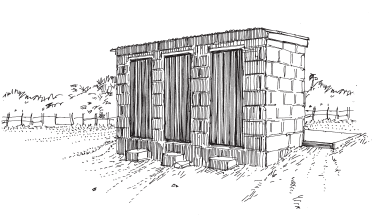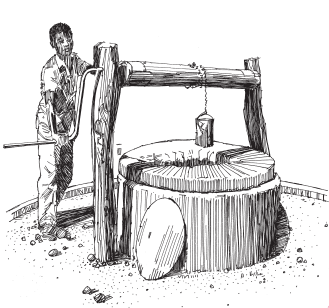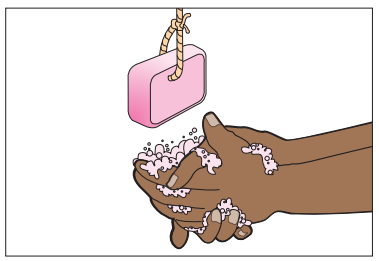Difference between revisions of "WASH in Schools Assessment"
(Published from sandbox) |
(→Acknowledgements) |
||
| (4 intermediate revisions by the same user not shown) | |||
| Line 1: | Line 1: | ||
| − | + | ||
The health and well-being of pupils and staff in schools will be greatly enhanced if there are enough clean water and sanitation facilities and everyone adopts the practice of handwashing with soap. Some benefits will be gained from improving one or other of these but not as much as if all three are improved. So it is important that you carry out an assessment of all three – water, sanitation and handwashing with soap – to decide which needs to be improved the most. | The health and well-being of pupils and staff in schools will be greatly enhanced if there are enough clean water and sanitation facilities and everyone adopts the practice of handwashing with soap. Some benefits will be gained from improving one or other of these but not as much as if all three are improved. So it is important that you carry out an assessment of all three – water, sanitation and handwashing with soap – to decide which needs to be improved the most. | ||
| Line 5: | Line 5: | ||
===Sanitation assessment=== | ===Sanitation assessment=== | ||
| − | [[Image:wash-escuela3.png|thumb|right|200px|Drawing: | + | [[Image:wash-escuela3.png|thumb|right|200px|Drawing: WEDC, Loughborough University]] |
Assessment of sanitation facilities is based on three criteria: quantity, quality and usage. Only by considering all three will you be able to accurately assess the current situation. | Assessment of sanitation facilities is based on three criteria: quantity, quality and usage. Only by considering all three will you be able to accurately assess the current situation. | ||
| Line 13: | Line 13: | ||
* '''Usage''' refers to the suitability of the facilities for the people who use them. A school may have many latrines and they may be well constructed and in good condition but they will not be used if they are located in the wrong place or not designed to account for local customs and cultural sensitivities. | * '''Usage''' refers to the suitability of the facilities for the people who use them. A school may have many latrines and they may be well constructed and in good condition but they will not be used if they are located in the wrong place or not designed to account for local customs and cultural sensitivities. | ||
| − | |||
| − | |||
| − | |||
| − | |||
| − | |||
| − | |||
===Water supply assessment=== | ===Water supply assessment=== | ||
| − | [[Image:wash-escuela2.png|thumb|right|200px|Drawing: | + | [[Image:wash-escuela2.png|thumb|right|200px|Drawing: WEDC, Loughborough University]] |
====Assessment criteria==== | ====Assessment criteria==== | ||
As with the assessment of sanitation facilities, assessment of a school’s water supply is also based on three criteria, this time: quantity, quality and convenience. Again, only by considering all three will you be able to assess the current situation accurately. | As with the assessment of sanitation facilities, assessment of a school’s water supply is also based on three criteria, this time: quantity, quality and convenience. Again, only by considering all three will you be able to assess the current situation accurately. | ||
| Line 31: | Line 25: | ||
* '''Convenience''' relates to how easy it is for children and staff to reach the water point and use it in the correct way. This includes the distance to the water source and the design of the water collection point. | * '''Convenience''' relates to how easy it is for children and staff to reach the water point and use it in the correct way. This includes the distance to the water source and the design of the water collection point. | ||
| − | |||
| − | |||
| − | |||
| − | |||
| − | |||
<br> | <br> | ||
===Handwashing assessment=== | ===Handwashing assessment=== | ||
| − | [[Image:wash-escuela.png|thumb|right|200px|Drawing: | + | [[Image:wash-escuela.png|thumb|right|200px|Drawing: WEDC, Loughborough University]] |
====Assessment criteria==== | ====Assessment criteria==== | ||
An assessment of children’s knowledge and practice of handwashing with soap is an indicator of the overall standard of hygiene in the school, but it may not reflect the overall standard of health as problems may be caused by inadequate sanitation facilities or a lack of a safe water supply. The results of an assessment of handwashing therefore, will normally need to be considered alongside the sanitation and water supply assessments. | An assessment of children’s knowledge and practice of handwashing with soap is an indicator of the overall standard of hygiene in the school, but it may not reflect the overall standard of health as problems may be caused by inadequate sanitation facilities or a lack of a safe water supply. The results of an assessment of handwashing therefore, will normally need to be considered alongside the sanitation and water supply assessments. | ||
| Line 46: | Line 35: | ||
| − | + | ===WASH in Schools links=== | |
| − | + | * [http://www.academia.edu/5044042/ASSESSMENT_OF_WATER_SANITATION_AND_HYGIENE_WASH_IN_MALAWI_PRIMARY_SCHOOLS ASSESSMENT OF WATER, SANITATION AND HYGIENE (WASH) IN MALAWI PRIMARY SCHOOLS.] | |
| − | + | * [http://www.unicef.org/wash/schools/files/Sierra_Leone_MHM_Booklet_DM_15_Nov_1020_single-Sierra_Leone.pdf WASH in Schools Empowers Girls’ Education in Freetown, Sierra Leone: An Assessment of Menstrual Hygiene Management in Schools] | |
| + | * [http://www.unicef.org/wash/schools/files/Bolivia_MHM_Booklet_DM_15_Nov_single_0940_Bolivia.pdf WASH in Schools Empowers Girls’ Education in Rural Cochabamba, Bolivia An Assessment of Menstrual Hygiene Management in Schools] | ||
| + | * [http://www.unicef.org/wash/schools/files/Philippines_MHM_Booklet_DM_15__Nov_1010_Single-_Philippines.pdf WASH in Schools Empowers Girls’ Education in Masbate Province and Metro Manila, Philippines An Assessment of Menstrual Hygiene Management in Schools] | ||
| + | * [http://www.sviluppodeipopoli.org/Italiano/NotizieEventi/scrivono/2013/CISP-RIWASHASSESSMENTREPORT.pdf WASH ASSESSMENT REPORT FOR NORTH AND SOUTH LEBANON]. October 2012. | ||
| + | * [http://www.washinschools.info/page/231 Methods and tools related to WASH in schools assessments.] | ||
| + | <br> | ||
===Acknowledgements=== | ===Acknowledgements=== | ||
| − | + | * [http://washinschoolsmapping.com/ WASH In Schools]. | |
| − | * [http:// | ||
Latest revision as of 01:24, 7 April 2016
The health and well-being of pupils and staff in schools will be greatly enhanced if there are enough clean water and sanitation facilities and everyone adopts the practice of handwashing with soap. Some benefits will be gained from improving one or other of these but not as much as if all three are improved. So it is important that you carry out an assessment of all three – water, sanitation and handwashing with soap – to decide which needs to be improved the most.
These tools use simple assessment criteria that are divided into four categories and are assigned a score.
Contents
Sanitation assessment
Assessment of sanitation facilities is based on three criteria: quantity, quality and usage. Only by considering all three will you be able to accurately assess the current situation.
- Quantity refers to the number of facilities. For boys, this will include not only the number of cubicles, but also the length of the urinals. Quantity is easy to measure, so in many cases it is the only guide used for assessment. However, quantity alone does not present a true picture.
- Quality refers to the condition of the facilities. A school may have many latrines but they will be unsafe to use if the floor is collapsing or the pit is full.
- Usage refers to the suitability of the facilities for the people who use them. A school may have many latrines and they may be well constructed and in good condition but they will not be used if they are located in the wrong place or not designed to account for local customs and cultural sensitivities.
Water supply assessment
Assessment criteria
As with the assessment of sanitation facilities, assessment of a school’s water supply is also based on three criteria, this time: quantity, quality and convenience. Again, only by considering all three will you be able to assess the current situation accurately.
- Quantity refers to the amount of water provided per child per day. Generally, this will also include the provision of enough water for staff but not for high water use activities such as irrigation or washing large floor areas.
- Quality relates to how clean and safe the water is. It is strongly recommended that the water supply is professionally tested for quality. If this is not possible, the descriptions given in the tables will give you a general indication.
- Convenience relates to how easy it is for children and staff to reach the water point and use it in the correct way. This includes the distance to the water source and the design of the water collection point.
Handwashing assessment
Assessment criteria
An assessment of children’s knowledge and practice of handwashing with soap is an indicator of the overall standard of hygiene in the school, but it may not reflect the overall standard of health as problems may be caused by inadequate sanitation facilities or a lack of a safe water supply. The results of an assessment of handwashing therefore, will normally need to be considered alongside the sanitation and water supply assessments.
For example, a situation where the average incidence of disease is high, but the scores for the handwashing criteria are low, may suggest that the sanitation and/or the water supply facilities need to be improved.
WASH in Schools links
- ASSESSMENT OF WATER, SANITATION AND HYGIENE (WASH) IN MALAWI PRIMARY SCHOOLS.
- WASH in Schools Empowers Girls’ Education in Freetown, Sierra Leone: An Assessment of Menstrual Hygiene Management in Schools
- WASH in Schools Empowers Girls’ Education in Rural Cochabamba, Bolivia An Assessment of Menstrual Hygiene Management in Schools
- WASH in Schools Empowers Girls’ Education in Masbate Province and Metro Manila, Philippines An Assessment of Menstrual Hygiene Management in Schools
- WASH ASSESSMENT REPORT FOR NORTH AND SOUTH LEBANON. October 2012.
- Methods and tools related to WASH in schools assessments.



